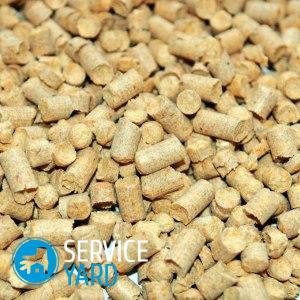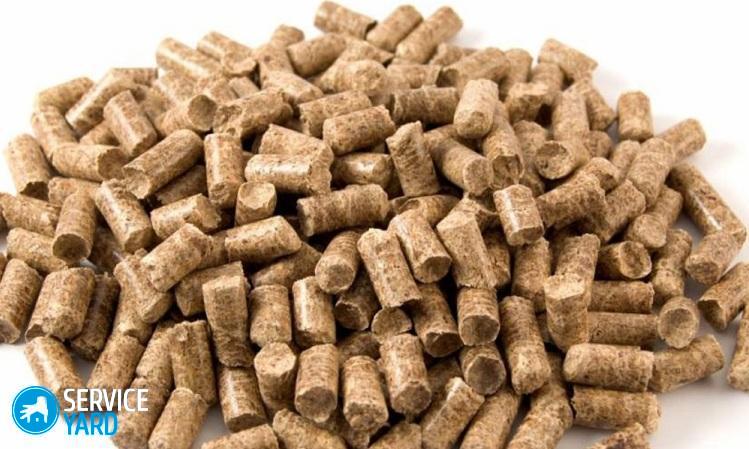What kind of filler can be flushed into the toilet?

The problem of disposal of filler for feline “latrine” is a real headache for owners of baleen-striped pets. Naturally, the most convenient option is to flush the used material into the toilet than to pack it in a bag and then throw it away. Some manufacturers of such products indicate that the filler can be disposed of by dropping down the drain. However, in reality, the picture is far from so rosy. If you throw a large amount of any filler into the toilet, it can cause blockage. It turns out that instead of saving energy and time, we get a rather serious problem, the resolution of which will take a lot of nerves. After reading this article, you will find out which filler can be flushed into the toilet and whether it is worth doing in principle.
to contents ↑Classification
There is only one correct answer to the question: “Is it possible to flush cat stuff into the toilet?”. It all depends on what material the filling is made of. As already mentioned, any kind of it can cause violations of the patency of sewer pipes, but some materials tolerate flushing better and others worse. Let's consider in more detail the most common options.
Woody
For its manufacture, pressed sawdust is used, sometimes with aromatic impregnations. When moistened, the wood first delaminates, and then gathers in lumps. The advantages of wood fillers include:
- Relatively low price.
- Ecological purity, the absence of harmful substances.
- Ease of disposal (it is much more convenient to get rid of it).
Disadvantages include the need for frequent replacement. If you do not replace the filling of the tray in time, then after 4-5 days you will begin to be bothered by unpleasant “aromas” from the side of the cat's tray.
Important! Practice shows that it is better to buy fillers without flavors. Fruit tree shavings have a natural, pleasant odor and mask mask stool odors. Artificial fragrances - on the contrary, form an intolerably sickening “amber” with cat urine. In addition, the smell of citrus scares away the animal.
Mineral
The basis of the mineral filler (for example, katsan) is bentonite clay, as well as other substances with good absorption capacity (vermiculite, zeolite). When wet, the mixture crumbles and is easily removed using a special scoop.
Important! The main advantage of clay materials is that they not only absorb liquid well, but also absorb odors.
Silica gel
This is the most modern and practical option, the only drawback of which is the relatively high cost. Such consumables can be changed once in 2-3 weeks, there is practically no unpleasant odor. But this filler is undesirable to use for kittens, because they gnaw granules, and this can harm the baby's health.
Paper
Unfortunately, paper-based fillers are rare in retail. The best here is considered Japanese products. It can be found on the sites of special online stores selling Japanese pet products. The downside is the high price.
Vegetable
Like paper, vegetable fillings (for example, corn) can be disposed of into the sewer. But, unfortunately, this is where their advantages end. Next are the solid cons:
- The filler is lightweight and therefore spreads throughout the apartment.
- Poorly neutralizes odors (2 days - and unbearable stink).
Important! This option can be used if the pet is allergic to all other types of materials.
A separate type of vegetable fillers is based on soy fiber. Unlike corn, they have excellent performance. The disadvantage is the same as paper products - high price.
to contents ↑How to dispose of the filler, or what kind of cat filler can be flushed into the toilet?
It all depends on how a particular material behaves in contact with water:
- Wood pellets in contact with water quickly soak. If you flush a small amount of granules from sawdust in the toilet, no problems will arise. However, an attempt to wash off a large amount of filler immediately, as a rule, ends in failure. Water from the tank is clearly not enough to wash away a lot of sawdust. While water fills the tank, the sawdust manages to be compressed into a rather weighty cork.
- Mineral filler gets off with a dense lump almost instantly. It is for this reason that it is impossible to flush the contents of the tray in the toilet. An exception to the rule is an attempt to flush small lumps through the sewer. At the same time, unpleasant consequences can be avoided. If you decide to pour all the filler from the tray into the sewer immediately, then the congestion inside the pipe is guaranteed. And to destroy it will be quite problematic. Thus, the answer to the question: “Is it possible to flush clumping filler into the toilet?” Is negative.
- Silica gel is consumed sparingly, it absorbs odors perfectly, but problems can arise with the disposal of granules in the toilet. When a large amount of material is poured into the sewer, the substance swells. Clogging does not occur in the toilet itself, but in the sewer pipes located below. It will not be possible to remove such a plug.
- Paper filling is perfectly utilized in the toilet, is one of the most environmentally friendly and safe options. This cat litter flush in the toilet is a real find for lazy owners.
Stock footage
Thus, one does not need to create difficulties for oneself. Do not flush into the sewer substances that are not intended for this. Paper and vegetable fillers are exceptions that support the rule. Disposal of the filler in a plastic bag for garbage will not take much time, and it is not worth the risk of wasting.
- How to choose a vacuum cleaner taking into account the characteristics of the house and coatings?
- What to look for when choosing a water delivery
- How to quickly create comfort at home - tips for housewives
- How to choose the perfect TV - useful tips
- What to look for when choosing blinds
- What should be running shoes?
- What useful things can you buy in a hardware store
- Iphone 11 pro max review
- Than iPhone is better than Android smartphones


